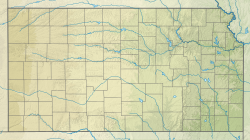The Booth | |
 The stadium in November 2023, two weeks before demolition of the west stands and north bowl. The east stands (left) remain standing. | |
| Former names | Memorial Stadium (1921–2017) |
|---|---|
| Location | 1101 Mississippi Street Lawrence, Kansas |
| Coordinates | 38°57′48″N 95°14′47″W / 38.96333°N 95.24639°W |
| Owner | University of Kansas |
| Operator | University of Kansas |
| Capacity | TBD[A] |
| Record attendance | 52,530 |
| Surface | FieldTurf |
| Construction | |
| Broke ground | May 10, 1921[1] |
| Opened | October 29, 1921 |
| Renovated | 1998, 2006, 2014, 2017, 2023—present |
| Expanded | 1927, 1963, 1965 |
| Construction cost | $275,000 ($4.7 million in 2023 dollars[2]) |
| Architect | LaForce Bailey and Clement C. Williams[1] Treanor Architects (renovations) |
| Tenants | |
| Kansas Jayhawks football (1921–2023, 2025-present) Kansas Jayhawks track and field (1922–2013) | |
David Booth Kansas Memorial Stadium is a college football stadium in Lawrence, Kansas, on the campus of the University of Kansas. The stadium was opened in 1921, and is the seventh oldest college football stadium in the country, and is widely recognized as the oldest west of the Mississippi River. It is the home stadium of the Kansas Jayhawks football team.
Nicknamed "The Booth",[3] the stadium is dedicated as a memorial to Kansas students who died in World War I, and is one of seven major veterans' memorials on the campus. The stadium is at the center of all seven war memorials—adjacent to the stadium, further up the hill is a Korean War memorial honoring Kansas students who served, just a few hundred feet south of the stadium stands the University of Kansas World War II Memorial, the Kansas Memorial Campanile and Carillon,[4] the University of Kansas Vietnam War Memorial sits adjacent to the Campanile to the west, the Victory Eagle – World War I statue located on Jayhawk Boulevard, southeast of the stadium, and the Kansas Memorial Union, a veterans' memorial that also houses the main university student union and bookstore, located east of the stadium.
On December 20, 2017, KU Chancellor Douglas Girod announced that the stadium would be renamed in honor of KU alumnus and donor David G. Booth, who pledged a donation of $50 million to overhaul the facility.[5]
Cite error: There are <ref group=upper-alpha> tags or {{efn-ua}} templates on this page, but the references will not show without a {{reflist|group=upper-alpha}} template or {{notelist-ua}} template (see the help page).
- ^ a b "Campus Buildings Directory". University of Kansas.
- ^ 1634–1699: McCusker, J. J. (1997). How Much Is That in Real Money? A Historical Price Index for Use as a Deflator of Money Values in the Economy of the United States: Addenda et Corrigenda (PDF). American Antiquarian Society. 1700–1799: McCusker, J. J. (1992). How Much Is That in Real Money? A Historical Price Index for Use as a Deflator of Money Values in the Economy of the United States (PDF). American Antiquarian Society. 1800–present: Federal Reserve Bank of Minneapolis. "Consumer Price Index (estimate) 1800–". Retrieved February 29, 2024.
- ^ "Kansas football: The Story behind 'The Booth' and Its Place in Jayhawk Lore". FanSided.com. September 18, 2019.
- ^ "Carillon". July 26, 2013.
- ^ Hancock, Peter (December 20, 2017). "KU Football Stadium to be Renamed after Donor David Booth". KU Sports. Retrieved December 20, 2017.

